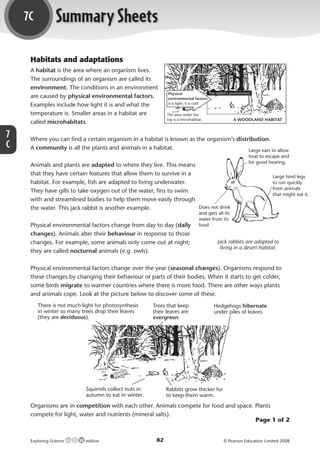More Related Content
Similar to Environment and feeding relationships
Similar to Environment and feeding relationships (20)
More from themassmaker (20)
Environment and feeding relationships
- 1. 7C Summary Sheets
Habitats and adaptations
A habitat is the area where an organism lives.
The surroundings of an organism are called its
environment. The conditions in an environment
Physical The rabbit’s environment
are caused by physical environmental factors. environmental factors:
Examples include how light it is and what the it is light; it is cold
temperature is. Smaller areas in a habitat are The area under the
log is a microhabitat. A WOODLAND HABITAT
called microhabitats.
7 Where you can find a certain organism in a habitat is known as the organism’s distribution.
C A community is all the plants and animals in a habitat. Large ears to allow
heat to escape and
for good hearing.
Animals and plants are adapted to where they live. This means
that they have certain features that allow them to survive in a Large hind legs
habitat. For example, fish are adapted to living underwater. to run quickly
from animals
They have gills to take oxygen out of the water, fins to swim
that might eat it.
with and streamlined bodies to help them move easily through
the water. This jack rabbit is another example. Does not drink
and gets all its
water from its
Physical environmental factors change from day to day (daily food
changes). Animals alter their behaviour in response to those
changes. For example, some animals only come out at night; Jack rabbits are adapted to
living in a desert habitat.
they are called nocturnal animals (e.g. owls).
Physical environmental factors change over the year (seasonal changes). Organisms respond to
these changes by changing their behaviour or parts of their bodies. When it starts to get colder,
some birds migrate to warmer countries where there is more food. There are other ways plants
and animals cope. Look at the picture below to discover some of these.
There is not much light for photosynthesis Trees that keep Hedgehogs hibernate
in winter so many trees drop their leaves their leaves are under piles of leaves.
(they are deciduous). evergreen.
Squirrels collect nuts in Rabbits grow thicker fur
autumn to eat in winter. to keep them warm.
Organisms are in competition with each other. Animals compete for food and space. Plants
compete for light, water and nutrients (mineral salts).
Page 1 of 2
Exploring Science edition 82 © Pearson Education Limited 2008
M03_ES_AB_Y7_2445_U7C.indd 82 4/3/08 10:21:17
- 2. 7C Summary Sheets (continued)
Feeding relationships
An animal that hunts other grass caterpillar robin sparrowhawk
animals is a predator. What producer consumers
it hunts is its prey. We can
show what eats what on a herbivore carnivore carnivore
food chain. Different words prey for the robin prey for the
sparrowhawk
are used to describe the
organisms in a food chain. predator of the predator of the
caterpillar robin
Food chains are joined to
form food webs. Food webs top predator
7
can also show omnivores C
(animals that eat both plants
and other animals).
Plants are producers because they can produce their own food. Energy from the Sun is used to
help them do this. This light energy is turned into chemical energy in the producer. When a
consumer eats a producer, the consumer gets the chemical energy.
Food chains and food webs show how energy is transfered through a community.
Animals that are predators have adaptations that allow them to catch their prey. Animals that are
prey have adaptations for avoiding being eaten!
Many predators have … Many prey have …
forward-facing eyes to pinpoint the position of their eyes on the sides of their heads so that they can
prey. keep a lookout behind them.
large, sharp claws. some form of protection (e.g. horns, spines or
armour).
Often, animals have adaptations for eating, either in or on their mouths:
Large
powerful beak
Sharp cutting
for crushing
teeth to slice
seeds.
through food.
Wide, ridged
teeth for
grinding up
grass.
You can find evidence of what has been eating something by:
• seeing it happen
• finding animal droppings or footprints near a damaged plant or dead animal
• finding teeth marks in a damaged plant or dead animal.
We can use this evidence to draw food chains and food webs for habitats.
Page 2 of 2
Exploring Science edition 83 © Pearson Education Limited 2008
M03_ES_AB_Y7_2445_U7C.indd 83 4/3/08 10:21:20
